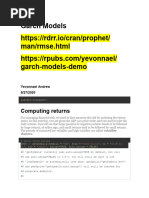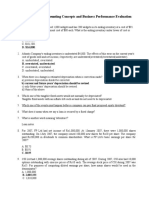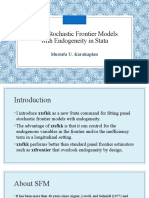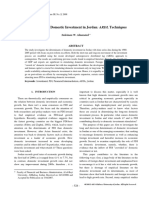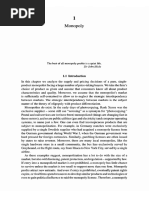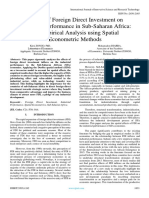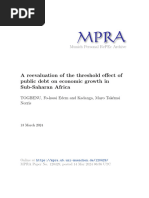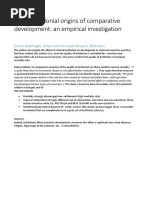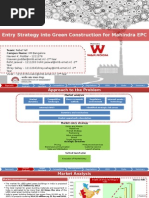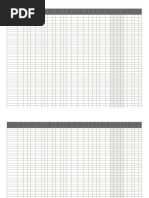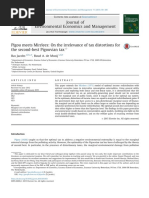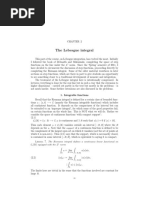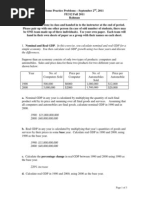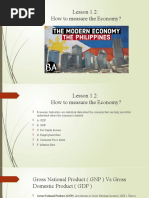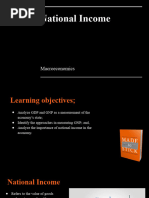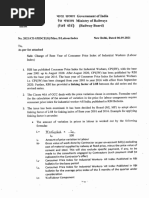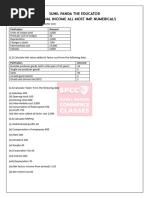Excel Work On HDI
Excel Work On HDI
Uploaded by
Subhangi NandiCopyright:
Available Formats
Excel Work On HDI
Excel Work On HDI
Uploaded by
Subhangi NandiOriginal Description:
Original Title
Copyright
Available Formats
Share this document
Did you find this document useful?
Is this content inappropriate?
Copyright:
Available Formats
Excel Work On HDI
Excel Work On HDI
Uploaded by
Subhangi NandiCopyright:
Available Formats
Table 1.
Human Development Index and its components
Index for Index for
Expected mean
Years of years of
Schoolin schoolin Educatui GNI Educatio
Human DevelopmentLifeIndex
expectancy
(HDI) at birth
Expected years of schooling
Mean years of schooling
Gross national income
GNI
(GNI)
perper
capita
capita
rank minus HDI rank HDI rank Health Index(HI) HI Rank g g on Index Index GNI Rank n Rank HDI Goal Post Value
HDI rank Country Value (years) (years) (years) (2011 PPP $) Min Max
2015 2015 2015 a 2015 a 2015 2015 2014 Life Expentncy 20 85
VERY HIGH HUMAN DEVELOPMENT Expected years of school 0 18
1 Norway 0.949 81.7 17.7 12.7 67,614 5 1 0.9492307692 17 0.9833333333
0.84666666670.915 0.901388518 6 7 0.9216548392 Mean Years Of School 0 15
2 Australia 0.939 82.5 20.4 b 13.2 42,822 19 3 0.9615384615 9 1.133333333 0.88 1.006666667
0.5703871829 20 1 0.8203654639 GNI Per Capita 100 75000
2 Switzerland 0.939 83.1 16 13.4 56,364 7 2 0.9707692308 5 0.8888888889
0.8933333333
0.8911111111
0.751188251 9 11 0.8661615136
4 Germany 0.926 81.1 17.1 13.2 c 45,000 13 4 0.94 22 0.95 0.88 0.915 0.5994659546 16 6 0.8018709686
5 Denmark 0.925 80.4 19.2 b 12.7 44,519 13 6 0.9292307692 30 1.066666667
0.8466666667
0.9566666667
0.5930440587 17 2 0.8078369763
5 Singapore 0.925 83.2 15.4 d 11.6 78,162 e -3 4 0.9723076923 4 0.8555555556
0.7733333333
0.8144444444
1.042216288 2 36 0.9380104594
7 Netherlands 0.924 81.7 18.1 b 11.9 46,326 8 6 0.9492307692 17 1.005555556
0.7933333333
0.8994444444
0.6171695594 14 8 0.8077002478
8 Ireland 0.923 81.1 18.6 b 12.3 43,798 11 8 0.94 22 1.033333333 0.82 0.9266666667
0.5834178905 18 5 0.7980137587
9 Iceland 0.921 82.7 19 b 12.2 c 37,065 20 9 0.9646153846 7 1.055555556
0.8133333333
0.9344444444
0.4935246996 28 4 0.7633766197
10 Canada 0.92 82.2 16.3 13.1 f 42,582 12 9 0.9569230769 12 0.9055555556
0.8733333333
0.8894444444
0.5671829105 21 12 0.7844639624
10 United States 0.92 79.2 16.5 13.2 53,245 1 11 0.9107692308 36 0.9166666667 0.88 0.8983333333
0.7095460614 11 9 0.8342101817
12 Hong Kong, China
0.917(SAR) 84.2 15.7 11.6 54,265 -2 12 0.9876923077 1 0.8722222222
0.7733333333
0.8227777778
0.723164219 10 30 0.8376200251
13 New Zealand 0.915 82 19.2 b 12.5 32,870 20 13 0.9538461538 14 1.066666667
0.8333333333 0.95 0.4375166889 32 3 0.7346246903
14 Sweden 0.913 82.3 16.1 12.3 46,251 2 15 0.9584615385 11 0.8944444444 0.82 0.8572222222
0.6161682243 15 19 0.7969953784
15 Liechtenstein 0.912 80.2 g 14.6 12.4 h 75,065 e,i -11 14 0.9261538462 32 0.8111111111
0.8266666667
0.8188888889
1.000867824 4 31 0.912210248
16 United Kingdom 0.909 80.8 16.3 13.3 37,931 10 16 0.9353846154 27 0.9055555556
0.8866666667
0.8961111111
0.5050867824 25 10 0.7508837334
17 Japan 0.903 83.7 15.3 12.5 c 37,268 10 17 0.98 2 0.85 0.8333333333
0.8416666667
0.49623498 26 22 0.7424796006
18 Korea (Republic0.901
of) 82.1 16.6 12.2 34,541 12 18 0.9553846154 13 0.9222222222
0.8133333333
0.8677777778
0.4598264352 29 18 0.7250927582
19 Israel 0.899 82.6 16 12.8 31,215 16 19 0.9630769231 8 0.8888888889
0.8533333333
0.8711111111
0.4154205607 34 17 0.7037323341
20 Luxembourg 0.898 81.9 13.9 12 62,471 -12 20 0.9523076923 16 0.7722222222 0.8 0.7861111111
0.8327236315 8 45 0.8542546908
21 France 0.897 82.4 16.3 11.6 38,085 4 22 0.96 10 0.9055555556
0.7733333333
0.8394444444
0.5071428571 24 24 0.7421035374
22 Belgium 0.896 81 16.6 11.4 41,243 1 21 0.9384615385 25 0.9222222222 0.76 0.8411111111
0.549305741 22 23 0.7568816835
23 Finland 0.895 81 17 11.2 f 38,868 1 23 0.9384615385 25 0.9444444444
0.7466666667
0.8455555556
0.5175967957 23 21 0.7433329795
24 Austria 0.893 81.6 15.9 11.3 c 43,609 -4 24 0.9476923077 19 0.8833333333
0.7533333333
0.8183333333
0.580894526 19 32 0.7665931962
25 Slovenia 0.89 80.6 17.3 12.1 28,664 13 25 0.9323076923 29 0.9611111111
0.8066666667
0.8838888889
0.3813618158 37 13 0.679878618
26 Italy 0.887 83.3 16.3 10.9 33,573 6 27 0.9738461538 3 0.9055555556
0.7266666667
0.8161111111
0.4469025367 31 35 0.7081916817
27 Spain 0.884 82.8 17.7 9.8 32,779 7 26 0.9661538462 6 0.9833333333
0.6533333333
0.8183333333
0.4363017356 33 32 0.7013279651
28 Czech Republic0.878 78.8 16.8 12.3 28,144 11 28 0.9046153846 38 0.9333333333 0.82 0.8766666667
0.3744192256 38 15 0.6671428993
29 Greece 0.866 81.1 17.2 10.5 24,808 16 29 0.94 22 0.9555555556 0.7 0.8277777778
0.3298798398 44 28 0.6355247434
30 Brunei Darussalam
0.865 79 14.9 9 f 72,843 -25 30 0.9076923077 37 0.8277777778 0.6 0.7138888889
0.9712016021 5 72 0.8569580365
30 Estonia 0.865 77 16.5 12.5 c 26,362 12 31 0.8769230769 47 0.9166666667
0.83333333330.875 0.3506275033 41 16 0.6455628206
32 Andorra 0.858 81.5 g 13.5 d 10.3 47,979 j -18 32 0.9461538462 20 0.75 0.6866666667
0.7183333333
0.6392389853 13 66 0.7573855426
33 Cyprus 0.856 80.3 14.3 11.7 29,459 4 34 0.9276923077 31 0.7944444444 0.78 0.7872222222
0.391975968 36 44 0.6590528574
33 Malta 0.856 80.7 14.6 11.3 29,500 3 35 0.9338461538 28 0.8111111111
0.7533333333
0.7822222222
0.3925233645 35 47 0.659412232
33 Qatar 0.856 78.3 13.4 9.8 129,916 e -32 33 0.8969230769 39 0.7444444444
0.6533333333
0.6988888889
1.733190921 1 81 1.028023983
36 Poland 0.855 77.6 16.4 11.9 24,117 11 36 0.8861538462 43 0.9111111111
0.7933333333
0.8522222222
0.3206542056 46 20 0.6233036076
37 Lithuania 0.848 73.5 16.5 12.7 26,006 7 37 0.8230769231 93 0.9166666667
0.8466666667
0.8816666667
0.3458744993 43 14 0.6307943531
38 Chile 0.847 82 16.3 9.9 21,665 16 38 0.9538461538 14 0.9055555556 0.66 0.7827777778
0.287917223 53 46 0.5990478152
38 Saudi Arabia 0.847 74.4 16.1 9.6 51,320 -26 38 0.8369230769 82 0.8944444444 0.64 0.7672222222
0.6838451268 12 53 0.760072158
40 Slovakia 0.845 76.4 15 12.2 26,764 1 40 0.8676923077 54 0.8333333333
0.8133333333
0.8233333333
0.3559946595 40 29 0.6335705418
41 Portugal 0.843 81.2 16.6 8.9 26,104 2 41 0.9415384615 21 0.9222222222
0.5933333333
0.7577777778
0.3471829105 42 56 0.6280286026
42 United Arab Emirates
0.84 77.1 13.3 k 9.5 c 66,203 -35 42 0.8784615385 46 0.7388888889
0.6333333333
0.6861111111
0.8825500668 7 85 0.8102496499
43 Hungary 0.836 75.3 15.6 12 23,394 6 43 0.8507692308 66 0.8666666667 0.8 0.8333333333
0.3110013351 48 27 0.60413073
44 Latvia 0.83 74.3 16 11.7 f 22,589 7 44 0.8353846154 84 0.8888888889 0.78 0.8344444444
0.3002536716 50 26 0.5937323909
45 Argentina 0.827 76.5 17.3 9.9 f 20,945 l 12 45 0.8692307692 53 0.9611111111 0.66 0.8105555556
0.2783044059 56 37 0.5809596723
45 Croatia 0.827 77.5 15.3 11.2 20,291 14 46 0.8846153846 44 0.85 0.7466666667
0.7983333333
0.2695727637 58 41 0.5752698159
47 Bahrain 0.824 76.7 14.5 k 9.4 m 37,236 -19 46 0.8723076923 51 0.8055555556
0.6266666667
0.7161111111
0.4958077437 27 68 0.6765830913
48 Montenegro 0.807 76.4 15.1 11.3 n 15,410 24 49 0.8676923077 54 0.8388888889
0.7533333333
0.7961111111
0.2044058745 71 42 0.5207280054
49 Russian Federation
0.804 70.3 15 12 23,286 1 48 0.7738461538 115 0.8333333333 0.8 0.8166666667
0.3095594126 49 34 0.5805163963
50 Romania 0.802 74.8 14.7 10.8 19,428 11 51 0.8430769231 76 0.8166666667 0.72 0.7683333333
0.2580507343 60 52 0.5508592655
51 Kuwait 0.8 74.5 13.3 7.3 76,075 e -48 50 0.8384615385 81 0.7388888889
0.4866666667
0.6127777778
1.01435247 3 118 0.804745113
52 Belarus 0.796 71.5 15.7 12 15,629 19 51 0.7923076923 108 0.8722222222 0.8 0.8361111111
0.207329773 70 25 0.5159486889
52 Oman 0.796 77 13.7 8.1 m 34,402 -21 53 0.8769230769 47 0.7611111111 0.54 0.6505555556
0.4579706275 30 103 0.6392849856
54 Barbados 0.795 75.8 15.3 10.5 n 14,952 20 54 0.8584615385 60 0.85 0.7 0.775 0.1982910547 73 50 0.5090673253
54 Uruguay 0.795 77.4 15.5 8.6 19,148 8 54 0.8830769231 45 0.8611111111
0.5733333333
0.7172222222
0.2543124166 61 67 0.5440931762
56 Bulgaria 0.794 74.3 15 10.8 c 16,261 13 57 0.8353846154 84 0.8333333333 0.72 0.7766666667
0.2157676903 68 49 0.5192412466
56 Kazakhstan 0.794 69.6 15 11.7 f 22,093 -3 56 0.7630769231 122 0.8333333333 0.78 0.8066666667
0.2936315087 52 39 0.5653989911
58 Bahamas 0.792 75.6 12.7 k 10.9 21,565 -3 58 0.8553846154 62 0.7055555556
0.7266666667
0.7161111111
0.2865821095 54 68 0.5599255786
59 Malaysia 0.789 74.9 13.1 10.1 24,620 -13 59 0.8446153846 74 0.7277777778
0.6733333333
0.7005555556
0.3273698264 45 79 0.5786021891
60 Palau 0.788 72.9 g 14.3 12.3 k 13,771 21 62 0.8138461538 102 0.7944444444 0.82 0.8072222222
0.1825233645 80 38 0.4931185009
60 Panama 0.788 77.8 13 9.9 19,470 0 60 0.8892307692 42 0.7222222222 0.66 0.6911111111
0.258611482 59 84 0.5416724157
62 Antigua and Barbuda
0.786 76.2 13.9 9.2 k 20,907 -4 61 0.8646153846 56 0.7722222222
0.6133333333
0.6927777778
0.2777970628 57 83 0.5500238465
63 Seychelles 0.782 73.3 14.1 9.4 k 23,886 -15 63 0.82 95 0.7833333333
0.62666666670.705 0.3175700935 47 75 0.5683478072
64 Mauritius 0.781 74.6 15.2 9.1 17,948 1 64 0.84 79 0.8444444444
0.6066666667
0.7255555556
0.2382910547 64 62 0.5256369651
65 Trinidad and Tobago
0.78 70.5 12.7 o 10.9 28,049 -25 64 0.7769230769 114 0.7055555556
0.7266666667
0.7161111111
0.3731508678 39 68 0.5921262255
66 Costa Rica 0.776 79.6 14.2 8.7 14,006 14 66 0.9169230769 33 0.7888888889 0.58 0.6844444444
0.1856608812 79 86 0.4884241969
66 Serbia 0.776 75 14.4 10.8 12,202 22 66 0.8461538462 69 0.8 0.72 0.76 0.1615754339 87 55 0.4701243565
68 Cuba 0.775 79.6 13.9 11.8 m 7,455 p 48 69 0.9169230769 33 0.7722222222
0.7866666667
0.7794444444
0.0981975968 114 48 0.4124832423
69 Iran (Islamic Republic
0.774 of) 75.6 14.8 8.8 f 16,395 -2 68 0.8553846154 62 0.8222222222
0.5866666667
0.7044444444
0.2175567423 66 76 0.5079959425
70 Georgia 0.769 75 13.9 12.2 8,856 38 71 0.8461538462 69 0.7722222222
0.8133333333
0.7927777778
0.1169025367 106 43 0.4280306927
71 Turkey 0.767 75.5 14.6 7.9 18,705 -7 72 0.8538461538 64 0.8111111111
0.5266666667
0.6688888889
0.2483978638 63 92 0.5215474444
71 Venezuela (Bolivarian
0.767 Republic of) 74.4 14.3 9.4 15,129 2 70 0.8369230769 82 0.7944444444
0.6266666667
0.7105555556
0.2006542056 72 73 0.4923159993
73 Sri Lanka 0.766 75 14 10.9 f 10,789 21 72 0.8461538462 69 0.7777777778
0.7266666667
0.7522222222
0.1427102804 92 57 0.4495212746
74 Saint Kitts and0.765
Nevis 74 g 13.7 8.4 k 22,436 -22 75 0.8307692308 89 0.7611111111 0.56 0.6605555556
0.2982109479 51 94 0.5469795782
75 Albania 0.764 78 14.2 9.6 10,252 24 75 0.8923076923 40 0.7888888889 0.64 0.7144444444
0.135540721 97 71 0.4420970639
76 Lebanon 0.763 79.5 13.3 8.6 m 13,312 8 74 0.9153846154 35 0.7388888889
0.5733333333
0.6561111111
0.1763951936 83 99 0.4731758631
77 Mexico 0.762 77 13.3 8.6 16,383 -9 77 0.8769230769 47 0.7388888889
0.5733333333
0.6561111111
0.2173965287 67 99 0.500108035
78 Azerbaijan 0.759 70.9 12.7 11.2 16,413 -12 77 0.7830769231 112 0.7055555556
0.7466666667
0.7261111111
0.2177970628 65 61 0.4984479822
79 Brazil 0.754 74.7 15.2 7.8 14,145 -1 79 0.8415384615 78 0.8444444444 0.52 0.6822222222
0.1875166889 77 87 0.4757147154
79 Grenada 0.754 73.6 15.8 8.6 k 11,502 13 80 0.8246153846 92 0.8777777778
0.5733333333
0.7255555556
0.1522296395 90 62 0.4499253273
81 Bosnia and Herzegovina
0.75 76.6 14.2 9 10,091 22 82 0.8707692308 52 0.7888888889 0.6 0.6944444444
0.1333911883 101 82 0.4320717858
82 The former Yugoslav
0.748 Republic of Macedonia
75.5 12.9 9.4 n 12,405 5 83 0.8538461538 64 0.7166666667
0.6266666667
0.6716666667
0.1642857143 86 91 0.455034586
83 Algeria 0.745 75 14.4 7.8 c 13,533 -1 84 0.8461538462 69 0.8 0.52 0.66 0.1793457944 81 96 0.4644027917
84 Armenia 0.743 74.9 12.7 11.3 8,189 28 85 0.8446153846 74 0.7055555556
0.7533333333
0.7294444444
0.1079973298 110 60 0.4052173905
84 Ukraine 0.743 71.1 15.3 11.3 f 7,361 34 81 0.7861538462 111 0.85 0.7533333333
0.8016666667
0.09694259012 116 40 0.3938570855
86 Jordan 0.741 74.2 13.1 10.1 10,111 15 85 0.8338461538 87 0.7277777778
0.6733333333
0.7005555556
0.1336582109 99 79 0.4274067582
87 Peru 0.74 74.8 13.4 9 11,295 6 89 0.8430769231 76 0.7444444444 0.6 0.6722222222
0.1494659546 91 90 0.4391782081
87 Thailand 0.74 74.6 13.6 7.9 14,519 -11 88 0.84 79 0.7555555556
0.5266666667
0.6411111111
0.1925100134 75 106 0.4697736335
89 Ecuador 0.739 76.1 14 8.3 10,536 6 87 0.8630769231 57 0.7777777778
0.5533333333
0.6655555556
0.1393324433 93 93 0.4309517912
90 China 0.738 76 13.5 7.6 c 13,345 -7 91 0.8615384615 58 0.75 0.5066666667
0.6283333333
0.176835781 82 111 0.4574514112
91 Fiji 0.736 70.2 15.3 k 10.5 f 8,245 20 91 0.7723076923 116 0.85 0.7 0.775 0.1087449933 109 50 0.4022540678
92 Mongolia 0.735 69.8 14.8 9.8 m 10,449 4 93 0.7661538462 120 0.8222222222
0.6533333333
0.7377777778
0.1381708945 94 59 0.427450709
92 Saint Lucia 0.735 75.2 13.1 9.3 m 9,791 14 90 0.8492307692 67 0.7277777778 0.62 0.6738888889
0.1293858478 104 89 0.4199203589
94 Jamaica 0.73 75.8 12.8 9.6 f 8,350 16 94 0.8584615385 60 0.7111111111 0.64 0.6755555556
0.1101468625 108 88 0.3997465102
95 Colombia 0.727 74.2 13.6 7.6 c 12,762 -10 95 0.8338461538 87 0.7555555556
0.5066666667
0.6311111111
0.1690520694 84 108 0.4464135989
96 Dominica 0.726 77.9 g 12.8 k 7.9 m 10,096 6 95 0.8907692308 41 0.7111111111
0.5266666667
0.6188888889
0.1334579439 100 115 0.4190258099
97 Suriname 0.725 71.3 12.7 8.3 m 16,018 -27 97 0.7892307692 109 0.7055555556
0.5533333333
0.6294444444
0.2125233645 69 110 0.4726315386
97 Tunisia 0.725 75 14.6 7.1 c 10,249 3 97 0.8461538462 69 0.8111111111
0.4733333333
0.6422222222
0.1355006676 98 105 0.4191396041
99 Dominican Republic
0.722 73.7 13.2 7.7 12,756 -13 101 0.8261538462 90 0.7333333333
0.5133333333
0.6233333333
0.1689719626 85 112 0.4431308403
99 Saint Vincent and
0.722the Grenadines 73 13.3 m 8.6 k 10,372 -1 99 0.8153846154 99 0.7388888889
0.5733333333
0.6561111111
0.1371428571 96 99 0.4186370867
101 Tonga 0.721 73 14.3 m 11.1 5,284 33 101 0.8153846154 99 0.7944444444 0.74 0.7672222222
0.06921228304 131 53 0.3511469931
102 Libya 0.716 71.8 13.4 k 7.3 c 14,303 -25 100 0.7969230769 106 0.7444444444
0.4866666667
0.6155555556
0.1896261682 76 117 0.45309991
103 Belize 0.706 70.1 12.8 10.5 7,375 14 103 0.7707692308 117 0.7111111111 0.7 0.7055555556
0.09712950601 115 74 0.3752052631
104 Samoa 0.704 73.7 12.9 d 10.3 d 5,372 27 104 0.8261538462 90 0.7166666667
0.6866666667
0.7016666667
0.07038718291 128 78 0.3442667816
105 Maldives 0.701 77 12.7 o 6.2 q 10,383 -8 105 0.8769230769 47 0.7055555556
0.4133333333
0.5594444444
0.1372897196 95 125 0.4068667135
105 Uzbekistan 0.701 69.4 r 12.2 12 m 5,748 21 108 0.76 125 0.6777777778 0.8 0.7388888889
0.07540720961 124 58 0.3485527655
107 Moldova (Republic
0.699of) 71.7 11.8 11.9 5,026 31 105 0.7953846154 107 0.6555555556
0.7933333333
0.7244444444
0.06576769025 135 64 0.3358909383
108 Botswana 0.698 64.5 12.6 9.2 c 14,663 -33 107 0.6846153846 148 0.7 0.6133333333
0.6566666667
0.1944325768 74 98 0.443799579
109 Gabon 0.697 64.9 12.6 8.1 q 19,044 -46 109 0.6907692308 145 0.7 0.54 0.62 0.2529238985 62 114 0.4766923478
110 Paraguay 0.693 73 12.3 8.1 8,182 3 110 0.8153846154 99 0.6833333333 0.54 0.6116666667
0.1079038718 111 119 0.3775473721
111 Egypt 0.691 71.3 13.1 7.1 f 10,064 -7 111 0.7892307692 109 0.7277777778
0.4733333333
0.6005555556
0.1330307076 102 120 0.398018293
111 Turkmenistan 0.691 65.7 10.8 9.9 k 14,026 -32 111 0.7030769231 141 0.6 0.66 0.63 0.1859279039 78 109 0.4350735238
113 Indonesia 0.689 69.1 12.9 7.9 10,053 -8 113 0.7553846154 127 0.7166666667
0.5266666667
0.6216666667
0.1328838451 103 113 0.3966425496
114 Palestine, State
0.684
of 73.1 12.8 8.9 5,256 21 115 0.8169230769 98 0.7111111111
0.5933333333
0.6522222222
0.06883845127 132 102 0.3322532841
115 Viet Nam 0.683 75.9 12.6 8 c 5,335 18 115 0.86 59 0.7 0.5333333333
0.6166666667
0.06989319092 130 116 0.3334222652
116 Philippines 0.682 68.3 11.7 9.3 8,395 -7 114 0.7430769231 131 0.65 0.62 0.635 0.1107476636 107 107 0.3738643235
117 El Salvador 0.68 73.3 13.2 6.5 7,732 -3 115 0.82 95 0.7333333333
0.4333333333
0.5833333333
0.1018958611 112 122 0.3652826657
118 Bolivia (Plurinational
0.674 State of) 68.7 13.8 8.2 6,155 6 118 0.7492307692 129 0.7666666667
0.5466666667
0.6566666667
0.0808411215 122 97 0.3413482143
119 South Africa 0.666 57.7 13 10.3 12,087 -30 119 0.58 175 0.7222222222
0.6866666667
0.7044444444
0.1600400534 88 76 0.4028726729
120 Kyrgyzstan 0.664 70.8 13 10.8 c 3,097 32 120 0.7815384615 113 0.7222222222 0.72 0.7211111111
0.04001335113 148 65 0.2825221414
121 Iraq 0.649 69.6 10.1 k 6.6 n 11,608 -30 121 0.7630769231 122 0.5611111111 0.44 0.5005555556
0.1536448598 89 140 0.3886090232
122 Cabo Verde 0.648 73.5 13.5 4.8 k 6,049 3 122 0.8230769231 93 0.75 0.32 0.535 0.0794259012 123 131 0.3270283874
123 Morocco 0.647 74.3 12.1 5 f 7,195 -4 123 0.8353846154 84 0.6722222222
0.3333333333
0.5027777778
0.09472630174 117 139 0.341384954
124 Nicaragua 0.645 75.2 11.7 6.5 f 4,747 16 124 0.8492307692 67 0.65 0.4333333333
0.5416666667
0.06204272363 137 130 0.3055973347
125 Guatemala 0.64 72.1 10.7 6.3 7,063 -4 126 0.8015384615 103 0.5944444444 0.42 0.5072222222
0.09296395194 119 138 0.3355926229
125 Namibia 0.64 65.1 11.7 6.7 f 9,770 -18 126 0.6938461538 144 0.65 0.4466666667
0.5483333333
0.129105474 105 127 0.3662273966
127 Guyana 0.638 66.5 10.3 8.4 c 6,884 -5 125 0.7153846154 137 0.5722222222 0.56 0.5661111111
0.0905740988 120 124 0.3322628344
127 Micronesia (Federated
0.638 States of) 69.3 11.7 k 9.7 d 3,291 22 126 0.7584615385 126 0.65 0.6466666667
0.6483333333
0.0426034713 145 104 0.2756717734
129 Tajikistan 0.627 69.6 11.3 10.4 q 2,601 30 129 0.7630769231 122 0.6277777778
0.6933333333
0.6605555556
0.03339118825 155 94 0.2562731937
130 Honduras 0.625 73.3 11.2 6.2 4,466 11 130 0.82 95 0.6222222222
0.4133333333
0.5177777778
0.05829105474 138 136 0.2914202487
131 India 0.624 68.3 11.7 6.3 c 5,663 -4 131 0.7430769231 131 0.65 0.42 0.535 0.07427236315 125 132 0.3090804952
132 Bhutan 0.607 69.9 12.5 3.1 n 7,081 -12 132 0.7676923077 119 0.6944444444
0.2066666667
0.4505555556
0.09320427236 118 155 0.3182661516
133 Timor-Leste 0.605 68.5 12.5 4.4 q 5,371 l -1 133 0.7461538462 130 0.6944444444
0.2933333333
0.4938888889
0.07037383178 129 142 0.2959985694
134 Vanuatu 0.597 72.1 10.8 o 6.8 n 2,805 23 134 0.8015384615 103 0.6 0.4533333333
0.5266666667
0.03611481976 153 133 0.2479601461
135 Congo 0.592 62.9 11.1 6.3 c 5,503 -7 135 0.66 156 0.6166666667 0.42 0.5183333333
0.07213618158 126 134 0.2911401321
135 Equatorial Guinea
0.592 57.9 9.2 k 5.5 q 21,517 -79 137 0.5830769231 174 0.5111111111
0.3666666667
0.4388888889
0.285941255 55 159 0.4182658617
137 Kiribati 0.588 66.2 11.9 7.8 k 2,475 23 136 0.7107692308 139 0.6611111111 0.52 0.5905555556
0.03170894526 156 121 0.2369865643
138 Lao People's Democratic
0.586 Republic 66.6 10.8 5.2 n 5,049 -2 137 0.7169230769 135 0.6 0.3466666667
0.4733333333
0.06607476636 133 150 0.2819844081
139 Bangladesh 0.579 72 10.2 5.2 c 3,341 8 140 0.8 105 0.5666666667
0.3466666667
0.4566666667
0.04327102804 143 154 0.2509740607
139 Ghana 0.579 61.5 11.5 6.9 f 3,839 5 140 0.6384615385 161 0.6388888889 0.46 0.5494444444
0.04991989319 140 126 0.2596833219
139 Zambia 0.579 60.8 12.5 6.9 f 3,464 7 139 0.6276923077 163 0.6944444444 0.46 0.5772222222
0.04491321762 142 123 0.2534085941
142 Sao Tome and0.574
Principe 66.6 12 5.3 3,070 12 142 0.7169230769 135 0.6666666667
0.3533333333 0.51 0.03965287049 150 137 0.2438404714
143 Cambodia 0.563 68.8 10.9 4.7 q 3,095 10 143 0.7507692308 128 0.6055555556
0.3133333333
0.4594444444
0.03998664887 149 153 0.2398196839
144 Nepal 0.558 70 12.2 4.1 n 2,337 19 144 0.7692307692 118 0.6777777778
0.2733333333
0.4755555556
0.02986648865 159 149 0.2218949191
145 Myanmar 0.556 66.1 9.1 m 4.7 f 4,943 -6 146 0.7092307692 140 0.5055555556
0.3133333333
0.4094444444
0.06465954606 136 167 0.2657898554
146 Kenya 0.555 62.2 11.1 6.3 f 2,881 10 147 0.6492307692 159 0.6166666667 0.42 0.5183333333
0.03712950601 152 134 0.2320469163
147 Pakistan 0.55 66.4 8.1 5.1 5,031 -10 148 0.7138461538 138 0.45 0.34 0.395 0.06583444593 134 169 0.2647798721
148 Swaziland 0.541 48.9 11.4 6.8 n 7,522 -33 149 0.4446153846 188 0.6333333333
0.4533333333
0.5433333333
0.09909212283 113 128 0.2882017782
149 Syrian Arab Republic
0.536 69.7 9 5.1 s 2,441 t 13 145 0.7646153846 121 0.5 0.34 0.42 0.03125500668 158 163 0.2157101791
150 Angola 0.533 52.7 11.4 5 q 6,291 -27 150 0.5030769231 182 0.6333333333
0.3333333333
0.4833333333
0.08265687583 121 146 0.2718859152
151 Tanzania (United
0.531
Republic of) 65.5 8.9 5.8 2,467 10 152 0.7 142 0.4944444444
0.3866666667
0.4405555556
0.03160213618 157 158 0.2136018718
152 Nigeria 0.527 53.1 10 6 q 5,443 -23 151 0.5092307692 181 0.5555555556 0.4 0.4777777778
0.07133511348 127 147 0.2589094964
153 Cameroon 0.518 56 10.4 6.1 c 2,894 2 154 0.5538461538 178 0.5777777778
0.4066666667
0.4922222222
0.03730307076 151 143 0.216653137
154 Papua New Guinea
0.516 62.8 9.9 k 4.3 f 2,712 4 153 0.6584615385 157 0.55 0.2866666667
0.4183333333
0.03487316422 154 164 0.2125762523
154 Zimbabwe 0.516 59.2 10.3 7.7 1,588 20 158 0.6030769231 168 0.5722222222
0.5133333333
0.5427777778
0.01986648865 170 129 0.18665457
156 Solomon Islands0.515 68.1 9.6 m 5.3 d 1,561 19 155 0.74 133 0.5333333333
0.3533333333
0.4433333333
0.01950600801 171 157 0.1856565039
157 Mauritania 0.513 63.2 8.5 4.3 f 3,527 -12 155 0.6646153846 154 0.4722222222
0.2866666667
0.3794444444
0.04575433912 141 171 0.2259697431
158 Madagascar 0.512 65.5 10.3 6.1 n 1,320 25 157 0.7 142 0.5722222222
0.4066666667
0.4894444444
0.01628838451 179 145 0.1773753037
159 Rwanda 0.498 64.7 10.8 3.8 1,617 14 162 0.6876923077 146 0.6 0.2533333333
0.4266666667
0.02025367156 169 160 0.1811321525
160 Comoros 0.497 63.6 11.1 4.8 q 1,335 22 160 0.6707692308 153 0.6166666667 0.32 0.4683333333
0.01648865154 178 151 0.1730232428
160 Lesotho 0.497 50.1 10.7 6.1 f 3,319 -12 161 0.4630769231 187 0.5944444444
0.4066666667
0.5005555556
0.04297730307 144 140 0.2151699049
162 Senegal 0.494 66.9 9.5 2.8 m 2,250 3 163 0.7215384615 134 0.5277777778
0.1866666667
0.3572222222
0.02870493992 161 174 0.1948579812
163 Haiti 0.493 63.1 9.1 k 5.2 c 1,657 9 164 0.6630769231 155 0.5055555556
0.3466666667
0.4261111111
0.02078771696 168 161 0.1804254743
163 Uganda 0.493 59.2 10 5.7 m 1,670 8 165 0.6030769231 168 0.5555555556 0.38 0.4677777778
0.02096128171 167 152 0.1808325933
165 Sudan 0.49 63.7 7.2 3.5 3,846 -22 165 0.6723076923 152 0.4 0.2333333333
0.3166666667
0.05001335113 139 181 0.2199980318
166 Togo 0.487 60.2 12 4.7 q 1,262 18 167 0.6184615385 166 0.6666666667
0.3133333333 0.49 0.01551401869 180 144 0.1675242551
167 Benin 0.485 59.8 10.7 3.5 c 1,979 1 168 0.6123076923 167 0.5944444444
0.2333333333
0.4138888889
0.02508678238 164 165 0.1852533834
168 Yemen 0.482 64.1 9 3 c 2,300 -4 159 0.6784615385 150 0.5 0.2 0.35 0.02937249666 160 177 0.1910636397
169 Afghanistan 0.479 60.7 10.1 3.6 f 1,871 1 169 0.6261538462 164 0.5611111111 0.24 0.4005555556
0.02364485981 166 168 0.1810062282
170 Malawi 0.476 63.9 10.8 4.4 f 1,073 16 170 0.6753846154 151 0.6 0.2933333333
0.4466666667
0.01299065421 182 156 0.1576601407
171 Côte d'Ivoire 0.474 51.9 8.9 5 f 3,163 -20 172 0.4907692308 183 0.4944444444
0.3333333333
0.4138888889
0.04089452603 147 165 0.2025235001
172 Djibouti 0.473 62.3 6.3 4.1 k 3,216 -22 171 0.6507692308 158 0.35 0.2733333333
0.3116666667
0.04160213618 146 182 0.2035843233
173 Gambia 0.452 60.5 8.9 3.3 f 1,541 3 173 0.6230769231 165 0.4944444444 0.22 0.3572222222
0.01923898531 172 174 0.1623880621
174 Ethiopia 0.448 64.6 8.4 2.6 q 1,523 5 174 0.6861538462 147 0.4666666667
0.1733333333 0.32 0.01899866489 175 180 0.1609773798
175 Mali 0.442 58.5 8.4 2.3 2,218 -9 175 0.5923076923 173 0.4666666667
0.1533333333 0.31 0.0282777036 162 183 0.173161392
176 Congo (Democratic
0.435Republic of the) 59.1 9.8 6.1 680 15 178 0.6015384615 171 0.5444444444
0.4066666667
0.4755555556
0.007743658211187 148 0.1303577769
177 Liberia 0.427 61.2 9.9 4.4 f 683 13 177 0.6338461538 162 0.55 0.2933333333
0.4216666667
0.007783711615186 162 0.1276575845
178 Guinea-Bissau0.424 55.5 9.2 m 2.9 k 1,369 3 179 0.5461538462 179 0.5111111111
0.1933333333
0.3522222222
0.01694259012 177 176 0.1482645025
179 Eritrea 0.42 64.2 5 3.9 k 1,490 1 181 0.68 149 0.2777777778 0.26 0.2688888889
0.01855807744 176 186 0.1502697569
179 Sierra Leone 0.42 51.3 9.5 3.3 f 1,529 -1 176 0.4815384615 186 0.5277777778 0.22 0.3738888889
0.0190787717 174 172 0.1508833497
181 Mozambique 0.418 55.5 9.1 3.5 q 1,098 4 182 0.5461538462 179 0.5055555556
0.2333333333
0.3694444444
0.01332443258 181 173 0.1390499873
181 South Sudan 0.418 56.1 4.9 4.8 n 1,882 -12 179 0.5553846154 177 0.2722222222 0.32 0.2961111111
0.0237917223 165 184 0.1575765098
183 Guinea 0.414 59.2 8.8 2.6 q 1,058 4 182 0.6030769231 168 0.4888888889
0.1733333333
0.3311111111
0.01279038718 183 179 0.1366920905
184 Burundi 0.404 57.1 10.6 3 c 691 5 184 0.5707692308 176 0.5888888889 0.2 0.3944444444
0.007890520694185 170 0.1211111199
185 Burkina Faso 0.402 59 7.7 1.4 q 1,537 -8 185 0.6 172 0.4277777778
0.09333333333
0.2605555556
0.01918558077 173 187 0.1442144726
186 Chad 0.396 51.9 7.3 2.3 n 1,991 -19 186 0.4907692308 183 0.4055555556
0.1533333333
0.2794444444
0.02524699599 163 185 0.1512844088
187 Niger 0.353 61.9 5.4 1.7 f 889 1 187 0.6446153846 160 0.3 0.1133333333
0.2066666667
0.01053404539 184 188 0.1119580766
188 Central African0.352
Republic 51.5 7.1 4.2 n 587 4 188 0.4846153846 185 0.3944444444 0.28 0.3372222222
0.00650200267 188 178 0.1020438515
OTHER COUNTRIES OR TERRITORIES
Korea (Democratic
.. People's Rep. of) 70.5 12 .. .. .. ..
Marshall Islands
.. .. .. .. 4,412 .. ..
Monaco .. .. .. .. .. .. ..
Nauru .. .. 9.7 k .. 12,058 .. ..
San Marino.. .. 15.1 .. 50,063 .. ..
Somalia .. 55.7 .. .. 294 .. ..
Tuvalu .. .. .. .. 5,395 .. ..
Human development groups
Very high human
0.892
development 79.4 16.4 12.2 39,605 — —
High human development
0.746 75.5 13.8 8.1 13,844 — —
Medium human 0.631
development 68.6 11.5 6.6 6,281 — —
Low human development
0.497 59.3 9.3 4.6 2,649 — —
Developing countries
0.668 70 11.8 7.2 9,257 — —
Regions
Arab States 0.687 70.8 11.7 6.8 14,958 — —
East Asia and the
0.72
Pacific 74.2 13 7.7 12,125 — —
Europe and Central
0.756Asia 72.6 13.9 10.3 12,862 — —
Latin America 0.751
and the Caribbean 75.2 14.1 8.3 14,028 — —
South Asia 0.621 68.7 11.3 6.2 5,799 — —
Sub-Saharan Africa
0.523 58.9 9.7 5.4 3,383 — —
Least developed
0.508
countries 63.6 9.4 4.4 2,385 — —
Small island developing
0.667 states 70.3 11.5 8.1 7,303 — —
Organisation for
0.887
Economic Co-operation
80.3and Development15.9 11.9 37,916 — —
World 0.717 71.6 12.3 8.3 14,447 — —
Notes
a. Data refer to 2015 or the most recent year available.
b. In calculating the HDI value, expected years of schooling is capped at 18 years.
c. Updated by HDRO using Barro and Lee (2016) estimates.
d. Based on data from the national statistical office.
e. In calculating the HDI value, GNI per capita is capped at $75,000.
f. Based on Barro and Lee (2016).
g. Value from UNDESA (2011).
h. Calculated as the average of mean years of schooling for Austria and Switzerland.
i. Estimated using the purchasing power parity (PPP) rate and projected growth rate of Switzerland.
j. Estimated using the PPP rate and projected growth rate of Spain.
k. Based on cross-country regression.
l. HDRO estimate based on data from World Bank (2016a) and United Nations Statistics Division (2016a)
m. Updated by HDRO based on data from UNESCO Institute for Statistics (2016).
n. Based on data from United Nations Children’s Fund (UNICEF) Multiple Indicator Cluster Surveys for 2006–2015.
o. Updated by HDRO based on data from ICF Macro Demographic and Health Surveys for 2006-2015.
p. Based on a cross-country regression and the projected growth rate from UNECLAC (2016).
q. Based on data from ICF Macro Demographic and Health Surveys for 2006-2015.
r. Value from WHO (2016).
s. Updated by HDRO based on Syrian Center for Policy Research (2016).
t. Based on projected growth rates from UNESCWA (2016) and World Bank (2016a).
Definitions
Human Development Index (HDI): A composite index measuring average achievement in three basic dimensions of human development—a long and healthy life, knowledge and a decent standard of living. See Technical note 1 at http://hdr.undp.org/sites/default/files/hdr2016_technical_notes.pdf for details on how the HDI is calculated.
Life expectancy at birth: Number of years a newborn infant could expect to live if prevailing patterns of age-specific mortality rates at the time of birth stay the same throughout the infant’s life.
Expected years of schooling: Number of years of schooling that a child of school entrance age can expect to receive if prevailing patterns of age-specific enrolment rates persist throughout the child’s life.
Mean years of schooling: Average number of years of education received by people ages 25 and older, converted from education attainment levels using official durations of each level.
Gross national income (GNI) per capita: Aggregate income of an economy generated by its production and its ownership of factors of production, less the incomes paid for the use of factors of production owned by the rest of the world, converted to international dollars using PPP rates, divided by midyear population.
GNI per capita rank minus HDI rank: Difference in ranking by GNI per capita and by HDI value. A negative value means that the country is better ranked by GNI than by HDI value.
HDI rank for 2014: Ranking by HDI value for 2014, which was calculated using the same most recently revised data available in 2016 that were used to calculate HDI values for 2015.
Main data sources
Columns 1 and 7: HDRO calculations based on data from UNDESA (2015a), UNESCO Institute for Statistics (2016), United Nations Statistica Division (2016a), World Bank (2016a), Barro and Lee (2016) and IMF (2016).
Column 2: UNDESA (2015a).
Column 3: UNESCO Institute for Statistics (2016), ICF Macro Demographic and Health Surveys and UNICEF Multple Indicator Cluster Surveys.
Column 4: UNESCO Institute for Statistics (2016), Barro and Lee (2016), ICF Macro Demographic and Health Surveys and UNICEF's Multple Indicator Cluster Surveys.
Column 5: World Bank (2016a), IMF (2016) and United Nations Statistica Division (2016a).
Column 6: Calculated based on data in columns 1 and 5.
HDI rank Country Human Development Index(HDI) Life Expectancy at birth Expected years of schooling Mean years of schooling Gross National Income(GNI) per capita GNI per capita rank minus HDI rank HDI rank Health Index(HI) HI Rank Index for Expected Years of Schooling Index for mean years of schooling Educatuion Index GNI Index GNI Rank Education Rank HDI
1 Norway 0.949 81.7 17.7 12.7 67,614 5 1
2 Australia 0.939 82.5 20.4 13.2 42,822 19 3
2 Switzerland 0.939 83.1 16 13.4 56,364 7 2
4 Germany 0.926 81.1 17.1 13.2 45,000 13 4
5 Denmark 0.925 80.4 19.2 12.7 44,519 13 6
5 Singapore 0.925 83.2 15.4 11.6 78,162 -3 4
7 Netherlands 0.924 81.7 18.1 11.9 46,326 8 6
8 Ireland 0.923 81.1 18.6 12.3 43,798 11 8
9 Iceland 0.921 82.7 19 12.2 37,065 20 9
10 Canada 0.92 82.2 16.3 13.1 42,582 12 9
10 United States 0.92 79.2 16.5 13.2 53,245 1 11
12 Hong Kong, China (SAR) 0.917 84.2 15.7 11.6 54,265 -2 12
13 New Zealand 0.915 82 19.2 12.5 32,870 20 13
14 Sweden 0.913 82.3 16.1 12.3 46,251 2 15
15 Liechtenstein 0.912 80.2 14.6 12.4 75,065 -11 14
16 United Kingdom 0.909 80.8 16.3 13.3 37,931 10 16
17 Japan 0.903 83.7 15.3 12.5 37,268 10 17
18 Korea (Republic of) 0.901 82.1 16.6 12.2 34,541 12 18
19 Israel 0.899 82.6 16 12.8 31,215 16 19
20 Luxembourg 0.898 81.9 13.9 12 62,471 -12 20
21 France 0.897 82.4 16.3 11.6 38,085 4 22
22 Belgium 0.896 81 16.6 11.4 41,243 1 21
23 Finland 0.895 81 17 11.2 38,868 1 23
24 Austria 0.893 81.6 15.9 11.3 43,609 -4 24
25 Slovenia 0.89 80.6 17.3 12.1 28,664 13 25
26 Italy 0.887 83.3 16.3 10.9 33,573 6 27
27 Spain 0.884 82.8 17.7 9.8 32,779 7 26
28 Czech Republic 0.878 78.8 16.8 12.3 28,144 11 28
29 Greece 0.866 81.1 17.2 10.5 24,808 16 29
30 Brunei Darussalam 0.865 79 14.9 9 72,843 -25 30
30 Estonia 0.865 77 16.5 12.5 26,362 12 31
32 Andorra 0.858 81.5 13.5 10.3 47,979 -18 32
33 Cyprus 0.856 80.3 14.3 11.7 29,459 4 34
33 Malta 0.856 80.7 14.6 11.3 29,500 3 35
33 Qatar 0.856 78.3 13.4 9.8 129,916 -32 33
36 Poland 0.855 77.6 16.4 11.9 24,117 11 36
37 Lithuania 0.848 73.5 16.5 12.7 26,006 7 37
38 Chile 0.847 82 16.3 9.9 21,665 16 38
38 Saudi Arabia 0.847 74.4 16.1 9.6 51,320 -26 38
40 Slovakia 0.845 76.4 15 12.2 26,764 1 40
41 Portugal 0.843 81.2 16.6 8.9 26,104 2 41
42 United Arab Emirates 0.84 77.1 13.3 9.5 66,203 -35 42
43 Hungary 0.836 75.3 15.6 12 23,394 6 43
44 Latvia 0.83 74.3 16 11.7 22,589 7 44
45 Argentina 0.827 76.5 17.3 9.9 20,945 12 45
45 Croatia 0.827 77.5 15.3 11.2 20,291 14 46
47 Bahrain 0.824 76.7 14.5 9.4 37,236 -19 46
48 Montenegro 0.807 76.4 15.1 11.3 15,410 24 49
49 Russian Federation 0.804 70.3 15 12 23,286 1 48
50 Romania 0.802 74.8 14.7 10.8 19,428 11 51
51 Kuwait 0.8 74.5 13.3 7.3 76,075 -48 50
52 Belarus 0.796 71.5 15.7 12 15,629 19 51
52 Oman 0.796 77 13.7 8.1 34,402 -21 53
54 Barbados 0.795 75.8 15.3 10.5 14,952 20 54
54 Uruguay 0.795 77.4 15.5 8.6 19,148 8 54
56 Bulgaria 0.794 74.3 15 10.8 16,261 13 57
56 Kazakhstan 0.794 69.6 15 11.7 22,093 -3 56
58 Bahamas 0.792 75.6 12.7 10.9 21,565 -3 58
59 Malaysia 0.789 74.9 13.1 10.1 24,620 -13 59
60 Palau 0.788 72.9 14.3 12.3 13,771 21 62
60 Panama 0.788 77.8 13 9.9 19,470 0 60
62 Antigua and Barbuda 0.786 76.2 13.9 9.2 20,907 -4 61
63 Seychelles 0.782 73.3 14.1 9.4 23,886 -15 63
64 Mauritius 0.781 74.6 15.2 9.1 17,948 1 64
65 Trinidad and Tobago 0.78 70.5 12.7 10.9 28,049 -25 64
66 Costa Rica 0.776 79.6 14.2 8.7 14,006 14 66
66 Serbia 0.776 75 14.4 10.8 12,202 22 66
68 Cuba 0.775 79.6 13.9 11.8 7,455 48 69
69 Iran (Islamic Republic of) 0.774 75.6 14.8 8.8 16,395 -2 68
70 Georgia 0.769 75 13.9 12.2 8,856 38 71
71 Turkey 0.767 75.5 14.6 7.9 18,705 -7 72
71 Venezuela (Bolivarian Republic of) 0.767 74.4 14.3 9.4 15,129 2 70
73 Sri Lanka 0.766 75 14 10.9 10,789 21 72
74 Saint Kitts and Nevis 0.765 74 13.7 8.4 22,436 -22 75
75 Albania 0.764 78 14.2 9.6 10,252 24 75
76 Lebanon 0.763 79.5 13.3 8.6 13,312 8 74
77 Mexico 0.762 77 13.3 8.6 16,383 -9 77
78 Azerbaijan 0.759 70.9 12.7 11.2 16,413 -12 77
79 Brazil 0.754 74.7 15.2 7.8 14,145 -1 79
79 Grenada 0.754 73.6 15.8 8.6 11,502 13 80
81 Bosnia and Herzegovina 0.75 76.6 14.2 9 10,091 22 82
82 The former Yugoslav Republic of Macedonia 0.748 75.5 12.9 9.4 12,405 5 83
83 Algeria 0.745 75 14.4 7.8 13,533 -1 84
84 Armenia 0.743 74.9 12.7 11.3 8,189 28 85
84 Ukraine 0.743 71.1 15.3 11.3 7,361 34 81
86 Jordan 0.741 74.2 13.1 10.1 10,111 15 85
87 Peru 0.74 74.8 13.4 9 11,295 6 89
87 Thailand 0.74 74.6 13.6 7.9 14,519 -11 88
89 Ecuador 0.739 76.1 14 8.3 10,536 6 87
90 China 0.738 76 13.5 7.6 13,345 -7 91
91 Fiji 0.736 70.2 15.3 10.5 8,245 20 91
92 Mongolia 0.735 69.8 14.8 9.8 10,449 4 93
92 Saint Lucia 0.735 75.2 13.1 9.3 9,791 14 90
94 Jamaica 0.73 75.8 12.8 9.6 8,350 16 94
95 Colombia 0.727 74.2 13.6 7.6 12,762 -10 95
96 Dominica 0.726 77.9 12.8 7.9 10,096 6 95
97 Suriname 0.725 71.3 12.7 8.3 16,018 -27 97
97 Tunisia 0.725 75 14.6 7.1 10,249 3 97
99 Dominican Republic 0.722 73.7 13.2 7.7 12,756 -13 101
99 Saint Vincent and the Grenadines 0.722 73 13.3 8.6 10,372 -1 99
101 Tonga 0.721 73 14.3 11.1 5,284 33 101
102 Libya 0.716 71.8 13.4 7.3 14,303 -25 100
103 Belize 0.706 70.1 12.8 10.5 7,375 14 103
104 Samoa 0.704 73.7 12.9 10.3 5,372 27 104
105 Maldives 0.701 77 12.7 6.2 10,383 -8 105
105 Uzbekistan 0.701 69.4 12.2 12 5,748 21 108
107 Moldova (Republic of) 0.699 71.7 11.8 11.9 5,026 31 105
108 Botswana 0.698 64.5 12.6 9.2 14,663 -33 107
109 Gabon 0.697 64.9 12.6 8.1 19,044 -46 109
110 Paraguay 0.693 73 12.3 8.1 8,182 3 110
111 Egypt 0.691 71.3 13.1 7.1 10,064 -7 111
111 Turkmenistan 0.691 65.7 10.8 9.9 14,026 -32 111
113 Indonesia 0.689 69.1 12.9 7.9 10,053 -8 113
114 Palestine, State of 0.684 73.1 12.8 8.9 5,256 21 115
115 Viet Nam 0.683 75.9 12.6 8 5,335 18 115
116 Philippines 0.682 68.3 11.7 9.3 8,395 -7 114
117 El Salvador 0.68 73.3 13.2 6.5 7,732 -3 115
118 Bolivia (Plurinational State of) 0.674 68.7 13.8 8.2 6,155 6 118
119 South Africa 0.666 57.7 13 10.3 12,087 -30 119
120 Kyrgyzstan 0.664 70.8 13 10.8 3,097 32 120
121 Iraq 0.649 69.6 10.1 6.6 11,608 -30 121
122 Cabo Verde 0.648 73.5 13.5 4.8 6,049 3 122
123 Morocco 0.647 74.3 12.1 5 7,195 -4 123
124 Nicaragua 0.645 75.2 11.7 6.5 4,747 16 124
125 Guatemala 0.64 72.1 10.7 6.3 7,063 -4 126
125 Namibia 0.64 65.1 11.7 6.7 9,770 -18 126
127 Guyana 0.638 66.5 10.3 8.4 6,884 -5 125
127 Micronesia (Federated States of) 0.638 69.3 11.7 9.7 3,291 22 126
129 Tajikistan 0.627 69.6 11.3 10.4 2,601 30 129
130 Honduras 0.625 73.3 11.2 6.2 4,466 11 130
131 India 0.624 68.3 11.7 6.3 5,663 -4 131
132 Bhutan 0.607 69.9 12.5 3.1 7,081 -12 132
133 Timor-Leste 0.605 68.5 12.5 4.4 5,371 -1 133
134 Vanuatu 0.597 72.1 10.8 6.8 2,805 23 134
135 Congo 0.592 62.9 11.1 6.3 5,503 -7 135
135 Equatorial Guinea 0.592 57.9 9.2 5.5 21,517 -79 137
137 Kiribati 0.588 66.2 11.9 7.8 2,475 23 136
138 Lao People's Democratic Republic 0.586 66.6 10.8 5.2 5,049 -2 137
139 Bangladesh 0.579 72 10.2 5.2 3,341 8 140
139 Ghana 0.579 61.5 11.5 6.9 3,839 5 140
139 Zambia 0.579 60.8 12.5 6.9 3,464 7 139
142 Sao Tome and Principe 0.574 66.6 12 5.3 3,070 12 142
143 Cambodia 0.563 68.8 10.9 4.7 3,095 10 143
144 Nepal 0.558 70 12.2 4.1 2,337 19 144
145 Myanmar 0.556 66.1 9.1 4.7 4,943 -6 146
146 Kenya 0.555 62.2 11.1 6.3 2,881 10 147
147 Pakistan 0.55 66.4 8.1 5.1 5,031 -10 148
148 Swaziland 0.541 48.9 11.4 6.8 7,522 -33 149
149 Syrian Arab Republic 0.536 69.7 9 5.1 2,441 13 145
150 Angola 0.533 52.7 11.4 5 6,291 -27 150
151 Tanzania (United Republic of) 0.531 65.5 8.9 5.8 2,467 10 152
152 Nigeria 0.527 53.1 10 6 5,443 -23 151
153 Cameroon 0.518 56 10.4 6.1 2,894 2 154
154 Papua New Guinea 0.516 62.8 9.9 4.3 2,712 4 153
154 Zimbabwe 0.516 59.2 10.3 7.7 1,588 20 158
156 Solomon Islands 0.515 68.1 9.6 5.3 1,561 19 155
157 Mauritania 0.513 63.2 8.5 4.3 3,527 -12 155
158 Madagascar 0.512 65.5 10.3 6.1 1,320 25 157
159 Rwanda 0.498 64.7 10.8 3.8 1,617 14 162
160 Comoros 0.497 63.6 11.1 4.8 1,335 22 160
160 Lesotho 0.497 50.1 10.7 6.1 3,319 -12 161
162 Senegal 0.494 66.9 9.5 2.8 2,250 3 163
163 Haiti 0.493 63.1 9.1 5.2 1,657 9 164
163 Uganda 0.493 59.2 10 5.7 1,670 8 165
165 Sudan 0.49 63.7 7.2 3.5 3,846 -22 165
166 Togo 0.487 60.2 12 4.7 1,262 18 167
167 Benin 0.485 59.8 10.7 3.5 1,979 1 168
168 Yemen 0.482 64.1 9 3 2,300 -4 159
169 Afghanistan 0.479 60.7 10.1 3.6 1,871 1 169
170 Malawi 0.476 63.9 10.8 4.4 1,073 16 170
171 Côte d'Ivoire 0.474 51.9 8.9 5 3,163 -20 172
172 Djibouti 0.473 62.3 6.3 4.1 3,216 -22 171
173 Gambia 0.452 60.5 8.9 3.3 1,541 3 173
174 Ethiopia 0.448 64.6 8.4 2.6 1,523 5 174
175 Mali 0.442 58.5 8.4 2.3 2,218 -9 175
176 Congo (Democratic Republic of the) 0.435 59.1 9.8 6.1 680 15 178
177 Liberia 0.427 61.2 9.9 4.4 683 13 177
178 Guinea-Bissau 0.424 55.5 9.2 2.9 1,369 3 179
179 Eritrea 0.42 64.2 5 3.9 1,490 1 181
179 Sierra Leone 0.42 51.3 9.5 3.3 1,529 -1 176
181 Mozambique 0.418 55.5 9.1 3.5 1,098 4 182
181 South Sudan 0.418 56.1 4.9 4.8 1,882 -12 179
183 Guinea 0.414 59.2 8.8 2.6 1,058 4 182
184 Burundi 0.404 57.1 10.6 3 691 5 184
185 Burkina Faso 0.402 59 7.7 1.4 1,537 -8 185
186 Chad 0.396 51.9 7.3 2.3 1,991 -19 186
187 Niger 0.353 61.9 5.4 1.7 889 1 187
188 Central African Republic 0.352 51.5 7.1 4.2 587 4 188
Other Countries and territories
Korea (Democratic People's Rep. of) .. 70.5 12 .. .. .. ..
Marshall Islands .. .. .. .. 4,412 .. ..
Monaco .. .. .. .. .. .. ..
Nauru .. .. 9.7 .. 12,058 .. ..
San Marino .. .. 15.1 .. 50,063 .. ..
Somalia .. 55.7 .. .. 294 .. ..
Tuvalu .. .. .. .. 5,395 .. ..
You might also like
- HPE ProLiant DL385 Gen11 QuickSpecDocument51 pagesHPE ProLiant DL385 Gen11 QuickSpecJoe DongNo ratings yet
- Tugas TPPE Indra SatrioDocument26 pagesTugas TPPE Indra SatrioIndra SatrioNo ratings yet
- TD Calcul StochastiqueDocument3 pagesTD Calcul StochastiquealexNo ratings yet
- Panel Stata InstructionsDocument4 pagesPanel Stata InstructionsMarjan NaseriNo ratings yet
- TD1MDBSDocument3 pagesTD1MDBSRoland Oscar Mondesir Konan100% (1)
- Drukker XTDPDDocument34 pagesDrukker XTDPDBenychouNo ratings yet
- FMOLS ModelDocument8 pagesFMOLS ModelSayed Farrukh AhmedNo ratings yet
- Pvar Stata ModulDocument29 pagesPvar Stata ModulYusuf IndraNo ratings yet
- Project On Conflict Management Pro Ace Infotech PatialaDocument11 pagesProject On Conflict Management Pro Ace Infotech PatialaBeant SinghNo ratings yet
- Analyse D'article: Trade & Human Development in OIC Contries - Zarinah, RuzitaDocument17 pagesAnalyse D'article: Trade & Human Development in OIC Contries - Zarinah, RuzitaHamza GanfoudNo ratings yet
- STATA CommandsDocument42 pagesSTATA Commandsmaz_wied74No ratings yet
- Testing Mediation Using Medsem' Package in StataDocument17 pagesTesting Mediation Using Medsem' Package in StataAftab Tabasam0% (1)
- Financial Econometrics and Empirical Finance - Module 2 General Exam Solutions - July 2012Document25 pagesFinancial Econometrics and Empirical Finance - Module 2 General Exam Solutions - July 2012Sunny DeolNo ratings yet
- Garch ModelsDocument38 pagesGarch Modelsives domeroNo ratings yet
- Support Evalua Projet 9dec 24Document29 pagesSupport Evalua Projet 9dec 24N'guessan Junior YaoNo ratings yet
- Ramsey Ccass KoopmanDocument56 pagesRamsey Ccass Koopmanranuv8030No ratings yet
- Structural VAR and Applications: Jean-Paul RenneDocument55 pagesStructural VAR and Applications: Jean-Paul RennerunawayyyNo ratings yet
- Dealing With Outlying Observations: Standard Practice ForDocument11 pagesDealing With Outlying Observations: Standard Practice ForCory BradleyNo ratings yet
- Stata Excel SpreadsheetDocument43 pagesStata Excel SpreadsheetAliNo ratings yet
- Tutorial Eviews Programming PDFDocument84 pagesTutorial Eviews Programming PDFHafid MohamedNo ratings yet
- 31 PDFDocument46 pages31 PDFTalin MachinNo ratings yet
- AFDM Quiz 1Document8 pagesAFDM Quiz 1Mohsin JalilNo ratings yet
- 3SLS and FIMLDocument5 pages3SLS and FIMLDavidBudinasNo ratings yet
- 3 SlsDocument31 pages3 SlsAldina SafiraNo ratings yet
- Table Loi NormaleDocument2 pagesTable Loi NormaleTony M'BHAYABONo ratings yet
- GMM StataDocument27 pagesGMM StataMao CardenasNo ratings yet
- Aboura, S. & Roye, B. (2017) Financial Stress and Economics Dynamics The Case of FranceDocument17 pagesAboura, S. & Roye, B. (2017) Financial Stress and Economics Dynamics The Case of FranceMateo ReinosoNo ratings yet
- Nonlinear Econometric Models: The Smooth Transition Regression ApproachDocument36 pagesNonlinear Econometric Models: The Smooth Transition Regression ApproachcleitonmoyaNo ratings yet
- Panel Stochastic Frontier Models With Endogeneity in Stata: Mustafa U. KarakaplanDocument13 pagesPanel Stochastic Frontier Models With Endogeneity in Stata: Mustafa U. KarakaplanMireya Ríos CaliNo ratings yet
- Ch. 18 Exercises On Equity ValuationDocument3 pagesCh. 18 Exercises On Equity Valuationclyon1547100% (1)
- 2SLS Klein Macro PDFDocument4 pages2SLS Klein Macro PDFNiken DwiNo ratings yet
- Mathematical LogicDocument9 pagesMathematical LogicdindinakNo ratings yet
- Ejercicois EviewsDocument10 pagesEjercicois EviewsJuan Meza100% (1)
- Stat331-Multiple Linear RegressionDocument13 pagesStat331-Multiple Linear RegressionSamantha YuNo ratings yet
- A Factor-Augmented Vector Autoregressive (Favar)Document18 pagesA Factor-Augmented Vector Autoregressive (Favar)Ingri QuevedoNo ratings yet
- Chapter 8. Small Open Economy in The Short Run: The Mundell-Fleming ModelDocument38 pagesChapter 8. Small Open Economy in The Short Run: The Mundell-Fleming ModelMinh HangNo ratings yet
- AIT HW 1Document5 pagesAIT HW 1Dwight Luther DoriaNo ratings yet
- Advantages of ARDL MODELDocument11 pagesAdvantages of ARDL MODELMuhammad Saeed MeoNo ratings yet
- Brochure Maths Fin 10-09-2019-1Document84 pagesBrochure Maths Fin 10-09-2019-1Abdoulaye CoulibalyNo ratings yet
- GDP DeflatorDocument22 pagesGDP DeflatorVivek Vashistha100% (1)
- Elmar Wolfstetter. Topics in Microeconomics Industrial Organization, Auctions, and Incentives. 21-150Document130 pagesElmar Wolfstetter. Topics in Microeconomics Industrial Organization, Auctions, and Incentives. 21-150Mafe Espinosa0% (1)
- Matlab Toolbox For MIDAS 2011Document24 pagesMatlab Toolbox For MIDAS 2011ManuNo ratings yet
- Fiscalité Abou El JaouadDocument280 pagesFiscalité Abou El Jaouadt.elmariniNo ratings yet
- Effects of Foreign Direct Investment On Industrial Performance in Sub-Saharan Africa: An Empirical Analysis Using Spatial Econometric MethodsDocument10 pagesEffects of Foreign Direct Investment On Industrial Performance in Sub-Saharan Africa: An Empirical Analysis Using Spatial Econometric MethodsInternational Journal of Innovative Science and Research TechnologyNo ratings yet
- Eviews 10 Tutorial: Introduction To EconometricsDocument43 pagesEviews 10 Tutorial: Introduction To EconometricsameenbahaaNo ratings yet
- Distributive Analysis Stata Package V2.3Document150 pagesDistributive Analysis Stata Package V2.3vicenteadriNo ratings yet
- Un Réexamen de L'effet de Seuil de La Dette Publique Sur La Croissance Économique en Afrique SubsaharienneDocument20 pagesUn Réexamen de L'effet de Seuil de La Dette Publique Sur La Croissance Économique en Afrique Subsahariennefougnigue tuoNo ratings yet
- EVIEWS Programming PDFDocument11 pagesEVIEWS Programming PDFAbdur RehmanNo ratings yet
- Robinsons Growth Model 2nd SemDocument27 pagesRobinsons Growth Model 2nd SemRanvika ChopraNo ratings yet
- Time Series - Eviews GuidelinesDocument36 pagesTime Series - Eviews GuidelinesTanuj AroraNo ratings yet
- Prof. Marouane ZAKHIR Chouaib Doukkali University Multidisciplinary Fcaulty of El Jadida English For Specific PurposesDocument14 pagesProf. Marouane ZAKHIR Chouaib Doukkali University Multidisciplinary Fcaulty of El Jadida English For Specific Purposesthe oneNo ratings yet
- Solutions - PS5 (DAE)Document23 pagesSolutions - PS5 (DAE)icisanmanNo ratings yet
- Resume of The Colonial Origins of Comparative Development: An Empirical InvestigationDocument1 pageResume of The Colonial Origins of Comparative Development: An Empirical InvestigationscholtestomNo ratings yet
- The Econometrics of Panel Data.A Handbook of The Theory With Applications. Matyas & Sevestre 1996 PDFDocument915 pagesThe Econometrics of Panel Data.A Handbook of The Theory With Applications. Matyas & Sevestre 1996 PDFCristian Alvarez HuillcaNo ratings yet
- Entry Strategy Into Green Construction For Mahindra EPC: Team: Rebel Yell Campus Name: IIM BangaloreDocument39 pagesEntry Strategy Into Green Construction For Mahindra EPC: Team: Rebel Yell Campus Name: IIM BangaloreSaurabh DwivediNo ratings yet
- APT+exercises+post 1Document6 pagesAPT+exercises+post 1Karan GambhirNo ratings yet
- DiscDoc ID40379 31-Jan-2023 ENGDocument6 pagesDiscDoc ID40379 31-Jan-2023 ENGhassan falihNo ratings yet
- DiscDoc ID40397 01-Feb-2023 ENGDocument6 pagesDiscDoc ID40397 01-Feb-2023 ENGhassan falihNo ratings yet
- DiscDoc_ID37934_01-Aug-2022_ENGDocument6 pagesDiscDoc_ID37934_01-Aug-2022_ENGhassan falihNo ratings yet
- From The Editor's Desk: Oikonomica: IDocument24 pagesFrom The Editor's Desk: Oikonomica: ISubhangi NandiNo ratings yet
- Journal of Environmental Economics and Management: Bas Jacobs, Ruud A. de MooijDocument19 pagesJournal of Environmental Economics and Management: Bas Jacobs, Ruud A. de MooijSubhangi NandiNo ratings yet
- William H Branson Macroeconomic Theory and Policy Universal Book Stall 1988 PDFDocument548 pagesWilliam H Branson Macroeconomic Theory and Policy Universal Book Stall 1988 PDFSubhangi NandiNo ratings yet
- Lancet2019 PDFDocument2 pagesLancet2019 PDFSubhangi NandiNo ratings yet
- COVID-19 Modelling The EpidemicDocument13 pagesCOVID-19 Modelling The EpidemicSubhangi NandiNo ratings yet
- Mandated, Targeted Social Isolation Can Flatten The COVID-19 CurveDocument5 pagesMandated, Targeted Social Isolation Can Flatten The COVID-19 CurveSubhangi NandiNo ratings yet
- Subhangi NotesDocument32 pagesSubhangi NotesSubhangi NandiNo ratings yet
- Data For 3RDclasses 2019.09.27Document259 pagesData For 3RDclasses 2019.09.27Subhangi NandiNo ratings yet
- ECON 1BB3 - Introduction To MacroeconomicsDocument16 pagesECON 1BB3 - Introduction To MacroeconomicsJeevikaGoyalNo ratings yet
- Practice Problems 9-2-11Document3 pagesPractice Problems 9-2-11Adel KamalNo ratings yet
- Price Index NumbersDocument1 pagePrice Index NumbersRekha chettyNo ratings yet
- Numericals National Income AccountingDocument22 pagesNumericals National Income AccountingPreeti BajajNo ratings yet
- Chapter 1 MCQDocument2 pagesChapter 1 MCQngothuphuong.mktNo ratings yet
- WEO DataDocument14 pagesWEO DataPrypiat 0No ratings yet
- Cpi Consumer Price Index in Hindi Upsc Notes in Hindi Fd80b9faDocument4 pagesCpi Consumer Price Index in Hindi Upsc Notes in Hindi Fd80b9faRohit AbhishekNo ratings yet
- Economics Chap 2Document90 pagesEconomics Chap 2xhaviNo ratings yet
- Lesson 1.2 GNP and GDPDocument17 pagesLesson 1.2 GNP and GDPpapasok lang beh Sige na vebs100% (1)
- Updated AGE303 Teaching NotesDocument46 pagesUpdated AGE303 Teaching Notesnochieng634No ratings yet
- NSS Exploring Economics 5 (3 Edition) : Revision NotesDocument2 pagesNSS Exploring Economics 5 (3 Edition) : Revision NotesinkeNo ratings yet
- Macro Chap - 2Document15 pagesMacro Chap - 2NamaamNo ratings yet
- Chapter 2Document10 pagesChapter 2Yasin IsikNo ratings yet
- Sangeeta Sarpal, PGT (Economics) JNV, PatialaDocument40 pagesSangeeta Sarpal, PGT (Economics) JNV, PatialameenakshiNo ratings yet
- Economics 9 - National IncomeDocument31 pagesEconomics 9 - National IncomeOliver VillanuevaNo ratings yet
- 2cont-Measuring The Cost of LivingDocument33 pages2cont-Measuring The Cost of LivingThảo UyênNo ratings yet
- What Does Gross National Income Say About A CountryDocument4 pagesWhat Does Gross National Income Say About A CountryQaiyum AzadNo ratings yet
- National Income - 1. Value Added MethodDocument30 pagesNational Income - 1. Value Added MethodRitish KumarNo ratings yet
- Revision Worksheet 4Document3 pagesRevision Worksheet 4Diya RathoreNo ratings yet
- 2021 - 09 - 06 RBCE - CE-I-CT Change of Base Year of Consumer Price Index of Industrial Workers (Labour Index)Document3 pages2021 - 09 - 06 RBCE - CE-I-CT Change of Base Year of Consumer Price Index of Industrial Workers (Labour Index)amitkap00rNo ratings yet
- Information On Previous Updates of The National Economic Accounts - U.S. Bureau of Economic Analysis (BEA)Document8 pagesInformation On Previous Updates of The National Economic Accounts - U.S. Bureau of Economic Analysis (BEA)jlkongNo ratings yet
- 13th RA Bill SupportingDocument21 pages13th RA Bill Supportinguut patangNo ratings yet
- CH 24Document28 pagesCH 24lbengtson1100% (1)
- Practice GDPDocument8 pagesPractice GDPKaia LorenzoNo ratings yet
- 12 Macro Economics Key Notes CH 02 National Income and Related AggregatesDocument14 pages12 Macro Economics Key Notes CH 02 National Income and Related AggregatesHackerzillaNo ratings yet
- 1Document28 pages1Mohammad Tariq AnsariNo ratings yet
- All Numerical National IncomeDocument3 pagesAll Numerical National IncomesarithaNo ratings yet
- Macro Unsolved Numericals English PDFDocument18 pagesMacro Unsolved Numericals English PDFNindoNo ratings yet
- Numericals On National Income Accounting 2019-20Document2 pagesNumericals On National Income Accounting 2019-20NIKITA SONINo ratings yet
- Macroeconomics 9th Edition Boyes Solutions Manual DownloadDocument7 pagesMacroeconomics 9th Edition Boyes Solutions Manual DownloadMichael Nickens100% (24)













